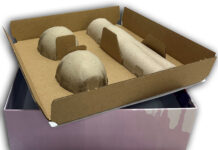By Paul Wilson, MD, Scorpion Vision Ltd
TECH advancements such as sophisticated sensor technology, Artificial Intelligence (AI) and faster microprocessors are conspiring to make line-scan camera technology a compelling option in a host of new areas.
Inline quality control of web printing processes is one of the most established fields of application for line-scan imaging — these fast cameras can often be found inspecting printed sheets or textiles for defects such as ink spot marks, embossing defects and mis-registered colours.
Beyond the printing industry, however, their use has been limited to niche pockets of application. In the electronics industry, for example, line-scan cameras are deployed for inspecting printed circuit boards, and in the food industry, they can be found on nut sorting lines, scanning product flows as they cascade in a curtain past the camera.
Essentially, in scenarios where a moving, continuous material needs to be analysed for faults or defects, line-scan cameras will generally provide a better solution than conventional area-scan cameras, owing to fundamental differences between the two cameras.
Area-scan vs line-scan cameras
Area-scan cameras capture the data for an entire image in one go and the dimensions of the resulting image correspond to the number of pixels on the sensor. Line-scan cameras, on the other hand, use a single row of light-sensitive pixels to constantly scan moving objects at a high frequency, capturing lots of ‘slices’ of an image which it then combines to construct the final image.
Because of this, area-scan cameras are not as suited to very fast web based applications but are easier to install and use than line-scan cameras, making them ideal for straightforward machine vision tasks.
That said, the advent of bigger, faster and more sensitive area-scan sensors means that it is not unusual to see a CMOS area-scan sensor being used where a line-scan camera would have been the default option. The ability to adjust the active area on the sensor means that a line-scan camera can be emulated in some cases.
The complexity of implementing line-scan cameras can be off-putting. Although capable of higher speed processing, line-scan cameras are more complicated and costly to install, mainly because the line rate of the camera must be synchronised to the speed of the object being detected.
Tech progress drives line-scan camera uptake
However, tech advancements in the last few years have meant that industries such as food, pharmaceuticals, e-commerce and logistics can no longer afford to ignore the performance advantages of line-scan cameras.
Advancements in Image Signal Processors (ISPs) are facilitating higher quality and faster processing of 3D images in more demanding environmental and lighting conditions. This enables the cameras to detect more critical detail and capture higher resolution images.
For example, HIKROBOT, represented by Scorpion Vision in the UK and Ireland, earlier this year launched a 16K line-scan camera that is capable of detecting minute defects in PCB, EV battery, semiconductor, print and film inspection applications.
At the same time, system designers are harnessing GPUs (Graphics Processing Units) from the gaming industry for image processing. This PC graphics hardware can reduce algorithm and data processing time and enables the use of AI-powered analysis.
Using AI to improve pattern matching capabilities improves and accelerates inspection performance. The combination of advanced image sensor technology and AI is enabling line-scan cameras to infer increasingly complex insights from the vast amounts of vision data they capture.
Sophisticated sensor technology has also provided solutions to the problem of adjusting the line rate to match the speed of the material under inspection, enabling accurate, meaningful 3D analysis of the image at high frequencies using software algorithms.
Making mincemeat of burger inspection
Scorpion Vision has recently designed an AI-powered line scanning system to inspect IQF burgers for visual abnormalities and defects. The bespoke system, which incorporates two Scorpion 3D Stinger cameras above and below the conveyor belt, ensures that every single burger that passes through the line is visually perfect – to meet the increasingly stringent presentation demands of both consumers and retailers.
The camera system will check each frozen burger is exactly the correct shape and size, shows no signs of discolouration, freezer burn or ice crystal formation and is free from unsightly visual abnormalities such as large lumps of fat.
There are two reasons why a line-scan camera is the best solution for this application. Firstly, the inspection needs to take place while the frozen burgers are being transported to a robotic pick & place packing system on a very fast moving conveyor belt. An area-scan camera would not be able to perform the required imaging at this high speed. The line-scanning system designed by Scorpion is able to locate, inspect and measure the burgers in real time.
Secondly, an area-scan camera would only able to image the surface that faces upwards, not the underside of the burger. With the line-scan system, the burgers are passed over a very narrow gap between two conveyors and two cameras (one above and one below the conveyor) build up a 3D image of the complete burger as it passes over the gap.
The scanning unit incorporates two 3D Stinger cameras built into enclosures with internal polarised light sources, an arrangement that enables robust acquisition of images on reflective surfaces. Scorpion Vision’s proprietary AI-optimised software analyses these images in real-time for reference features that have been established through deep learning, and any burgers that exhibit abnormalities are immediately rejected from the line.
This is only the start of what is possible when AI is combined with fast scanning technology, but it demonstrates how AI-enabled line scanning systems are breaking new ground in inspection speed, accuracy and repeatability.














